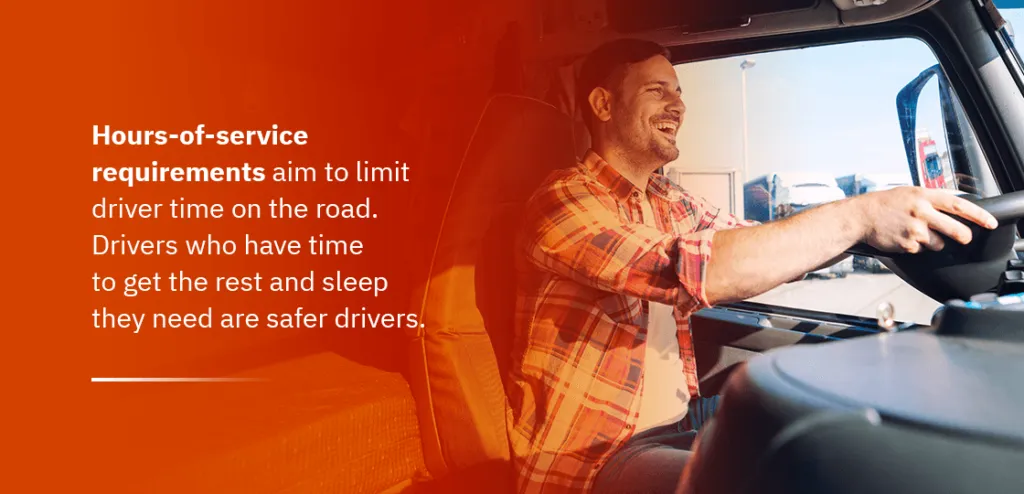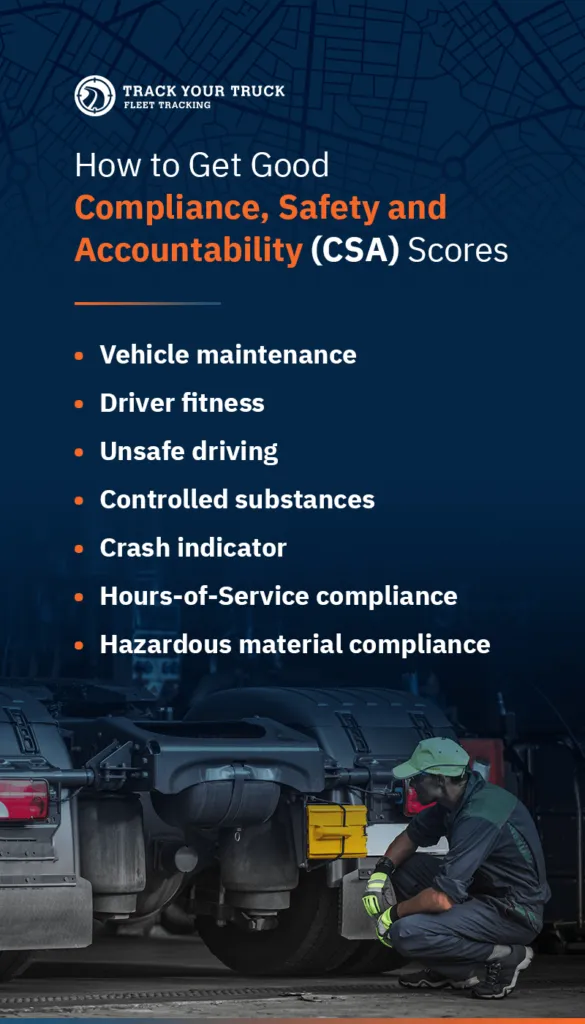

Commercial motor vehicles play a substantial role in the economy. Nearly two-thirds of freight transported across the U.S. is moved by motor vehicles. In addition to transporting billions of tons of products, motor vehicles also transport people from place to place. The commercial motor vehicle industry also employs millions of people.
Safety is one thing that keeps motor vehicles moving. Without safety measures and regulations in place, deliveries would be less efficient, and passengers would have a more challenging time getting to their destinations.
For that reason, the U.S. Department of Transportation (DOT)’s Federal Motor Carrier Safety Administration (FMCSA) enforces regulations that aim to reduce fatalities, injuries and crashes among buses and large trucks. Your fleet most likely needs to comply with FMCSA’s guidelines and regulations. Here’s how to do it.
The FMCSA has a series of regulations that drivers and fleet managers need to follow when they are on the road. If a fleet doesn’t comply with the rules, they risk penalties and fines. The fines for non-compliance can be hefty.
The regulations cover all areas of the motor vehicle industry. There are regulations overseeing:
Fleet compliance is crucial to keeping your drivers safe and ensuring your business performs at its fullest potential.

The U.S. DOT is an executive department responsible for creating policies for an economical and efficient national transportation system. The department was established by Congress in 1966 to provide an executive-level position for transportation and to replace the under-secretary of commerce for transportation. Its first official day of operation was April 1, 1967.
Today, the DOT consists of 13 administrations responsible for air, land and sea travel.
The FMCSA is one of the DOT’s 13 administrations. It regulates the trucking industry and has the primary goal of reducing crashes and fatalities.
The Motor Carrier Safety Improvement Act of 1999 created the FMCSA, and the agency came into existence in 2000. Today, some of the roles of the agency include:
To achieve its mission and goals, FMCSA has three primary programs:
The FMCSA enforces the DOT’s rules and regulations. Some of the regulations your fleet needs to comply with include:
Any commercial motor vehicle (CMV) operator in the U.S. needs to comply with the DOT’s regulations and guidelines. The Federal Register defines a CMV as:
If there are any CMVs in your fleet, you need to ensure you comply with the DOT’s regulations and guidelines.

Tired drivers are a serious safety concern. Hours-of-service requirements aim to limit driver time on the road. Drivers who have time to get the rest and sleep they need are safer drivers.
How long a person can drive a CMV depends on the type of vehicle they’re driving and what they’re carrying in the vehicle. Someone transporting products can drive for up to 11 hours after a 10-hour rest. A driver transporting people can drive for up to 10 hours after an eight-hour rest. Drivers have either a 14 or 15-hour window to drive their allowed 10 or 11 hours.
After driving for eight hours, a driver transporting products needs to take a 30-minute break from driving. They can still be on duty during the break. They just can’t be behind the wheel.
During a seven-day period, drivers can’t be behind the wheel for more than 60 hours. In an eight-day period, they can’t drive for more than 70 hours. Taking at least 34 consecutive hours off allows a driver to reset the clock on the 60 or 70-hour drive limitation.
Drivers can comply with the hours-of-service regulations by using electronic logging devices (ELDs). A mandate requires drivers to use ELDs to track their driver time and ensure they aren’t on the road for longer than allowed.
FMCSA regulations require drivers to inspect their vehicles before driving for the day. Drivers also have to inspect their vehicles and fill out a report at the end of the day or after each trip. These reports are called Driver Vehicle Inspection Reports (DVIR).
Even if the FMCSA didn’t require DVIRs, having drivers inspect their trucks before and after trips is a good idea. Regular inspections allow drivers to detect safety issues or problems before they can cause considerable damage or lead to a crash or injury. Filling out DVIRs regularly will help drivers recognize things that are out of the ordinary with their vehicle quickly.
If a driver is on the road, they can get stopped by a DOT agent. The agent will use a DVIR checklist when inspecting the truck. If the agent finds an issue that the driver didn’t notice or didn’t bother to repair, the fleet operator and driver can be subject to fines, and the motor vehicle won’t pass inspection.
Some of the steps found on the DVIR include checking the truck’s:
The checklist also includes items that should be checked on the trailer, if there is one, such as the trailer’s wheels and tires, brakes and coupling pin.
When completing a DVIR, the driver should provide details about any issues in the remarks section. They also need to state whether the vehicle is safe to drive or if repairs must be made before the truck is taken on the road again. If problems get fixed, both the driver and the mechanic must sign and date the report.
Before the early 1980s, drivers had to get fuel tax permits for each state they operated their trucks in. They had to display their permits on a license plate attached to the truck. Getting the correct permits was a complicated process. The International Fuel Tax Agreement (IFTA) sought to simplify things.
The lower 48 states and 10 Canadian provinces have adopted IFTA. Alaska and the Canadian territories also use it. Under the IFTA, drivers of certain vehicles need to complete an IFTA report every quarter. They need to log the number of miles driven, their fuel purchases and the locations where they bought fuel.
A driver submits the report, plus receipts for gas purchases, to their local IFTA office each quarter. The IFTA office decides which provinces and states get fuel taxes based on how many miles truckers drive on the road.
Remembering to log hours and purchases can get complicated, particularly if a driver does it after the fact. GPS tracking makes it easier for drives to keep tabs on where they drove and accurately record that information on their IFTA report.

The CSA Safety Measurement System (SMS) conducts roadside inspections to identify which motor carriers pose the biggest safety risk and evaluate carriers’ safety performance. The CSA’s program is meant to keep fleets and carriers, rather than individual drivers, in check. If a CSA inspector notes numerous issues during a roadside inspection, it’s the carrier that will face the consequences, not the driver.
The CSA SMS uses seven categories, called Behavior Analysis and Safety Improvement Categories (BASICs), to determine safety on the road. Knowing the criteria of each category can help you improve your CSA score.
The ideal CSA score is zero or very close to it. The closer your score is to 100, the more safety issues the SMS program has detected. You’ll likely see lower insurance premiums and fewer inspections if you have a lower score. Having a low score also helps to improve your fleet’s reputation, leading to more business.
Your fleet’s drivers play a major role in overall safety. Their behavior on the road and off also affect your company’s reputation. Before hiring anyone, it’s crucial to conduct a pre-employment screening. FMCSA regulations require employers to gather specific information on drivers before they’re hired.
Screening a potential driver involves attaining their driving history and accident record. You can examine their crash data to see if they are likely to drive unsafely. Reviewing any roadside inspection reports involving the potential new hire gives you an idea of whether they have a history of due diligence and maintenance.
Drug and alcohol screenings should also be part of the pre-employment check. You can have potential hires take a drug test. You can also search in the Drug and Alcohol Clearinghouse to find any past violations.

GPS fleet tracking software helps you see where your drivers go each day and can help you comply with FMCSA’s regulations. Fleet tracking systems from Track Your Truck also help you streamline your operations while staying compliant. We are committed to providing quality tracking systems for your fleet and have more than 23 years of experience in vehicle tracking. Call us at 888-434-3846 or request a quote today.